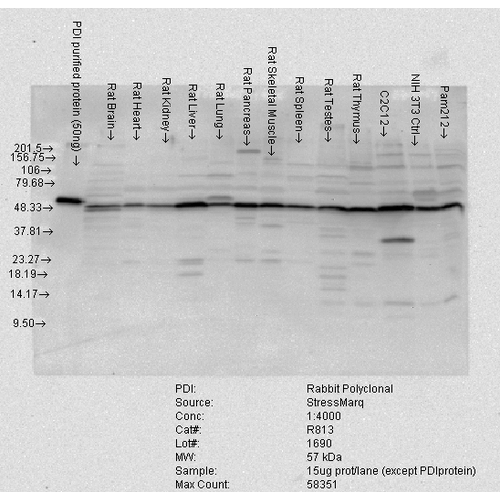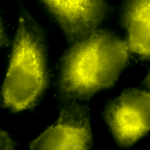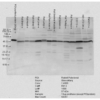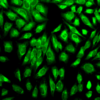Properties
| Storage Buffer | PBS pH7.4, 50% glycerol, 0.09% sodium azide *Storage buffer may change when conjugated |
| Storage Temperature | -20ºC, Conjugated antibodies should be stored according to the product label |
| Shipping Temperature | Blue Ice or 4ºC |
| Purification | Protein A purified |
| Clonality | Polyclonal |
| Specificity | Detects ~58kDa. |
| Cite This Product | StressMarq Biosciences Cat# SPC-114, RRID: AB_2156444 |
| Certificate of Analysis | A 1:1000 dilution of SPC-114 was sufficient for detection of PDI in 20 µg of HeLa cell lysate by ECL immunoblot analysis. |
Biological Description
| Alternative Names | PDI Antibody, PDIA1 Antibody, PDIP Antibody, pancreatic protein disulfide isomerase Antibody |
| Research Areas | Cell Signaling, Chaperone Proteins, Organelle Markers, Protein Trafficking, Tags and Cell Markers |
| Cellular Localization | Endoplasmic Reticulum, Endoplasmic reticulum lumen |
| Swiss Prot | P04785 |
| Scientific Background | The three dimensional structure of many extracellular proteins is stabilized by the formation of disulphide bonds. Studies suggest that a microsomal enzyme known as Protein Disulphide Isomerase (PDI) is involved in disulphide-bond formation via its oxidase activity and isomerization via its isomerase activity, as well as the reduction of disulphide bonds in proteins (1). Studies suggest BiP and PDI work together sequentially to increase oxidation of these proteins (2, 3). PDI has also been found to function as a chaperone to prevent the aggregation of unfolded substrates, and serves as a subunit of prolyl 4-hydroxylase and microsomal triglyceride transferase (4, 5). PDI is an abundant 55kDa protein located primarily in the ER, however studies have also proved its presence in the cytosol (1). PDI has the ability to reside in the ER permanently due to the highly conserved KDEL sequence at its carboxy-terminus (6). It uses carboxy-terminal KDEL as a retention signal, and this appears to be sufficient to reduce the secretion of proteins from the ER. This retention is reported to be mediated by a KDEL receptor (7). |
| References |
1. NA K.S. et al. (2007) Mol Cells. 24(2): 261-7. 2. Mayer M., Kies U., Kammermeier R., and Buchner J. (2000) J Biol Chem. 275(38): 29421-5. 3. Delom F., Mallet B., Carayon P., and Lejeune P.J. (2001) J Biol Chem 276(24): 21337-42. 4. Schultz-Norton J.R., McDonald W.H., Yates J.R. and Nardulli A.M. (2006) Mol Endocrinol 20(9): 1982-95. 5. Turano C., Coppari S. Altieri F. and Ferraro (2002) J Cell Physiol 193: 154-163. 6. Janiszewski M. (2005) J. Biol Chem. 280(49): 40813- 40819. 7. Yoshimori T., et al. (1990) J Biol Chem. 265(26): 15984-90. |
Product Images

Immunocytochemistry/Immunofluorescence analysis using Rabbit Anti-PDI Polyclonal Antibody (SPC-114). Tissue: Cervical cancer cell line (HeLa). Species: Human. Fixation: 2% Formaldehyde for 20 min at RT. Primary Antibody: Rabbit Anti-PDI Polyclonal Antibody (SPC-114) at 1:100 for 12 hours at 4°C. Secondary Antibody: R-PE Goat Anti-Rabbit (yellow) at 1:200 for 2 hours at RT. Counterstain: DAPI (blue) nuclear stain at 1:40000 for 2 hours at RT. Localization: Endoplasmic reticulum lumen. Melanosome. Magnification: 100x. (A) DAPI (blue) nuclear stain. (B) Anti-PDI Antibody. (C) Composite.

Western blot analysis of Rat tissue mix showing detection of PDI protein using Rabbit Anti-PDI Polyclonal Antibody (SPC-114). Load: 15 µgprotein. Block: 1.5% BSA. Primary Antibody: Rabbit Anti-PDI Polyclonal Antibody (SPC-114) at 1:4000 for 2 hours at RT. Secondary Antibody: Donkey Anti-Rabbit IgG: HRP for 1 hour at RT.

Immunocytochemistry/Immunofluorescence analysis using Rabbit Anti-PDI Polyclonal Antibody (SPC-114). Tissue: Cervical cancer cell line (HeLa). Species: Human. Fixation: 2% Formaldehyde for 20 min at RT. Primary Antibody: Rabbit Anti-PDI Polyclonal Antibody (SPC-114) at 1:100 for 12 hours at 4°C. Secondary Antibody: FITC Goat Anti-Rabbit (green) at 1:200 for 2 hours at RT. Counterstain: DAPI (blue) nuclear stain at 1:40000 for 2 hours at RT. Localization: Endoplasmic reticulum lumen. Melanosome. Magnification: 20x. (A) DAPI (blue) nuclear stain. (B) Anti-PDI Antibody. (C) Composite.
























StressMarq Biosciences :
Based on validation through cited publications.